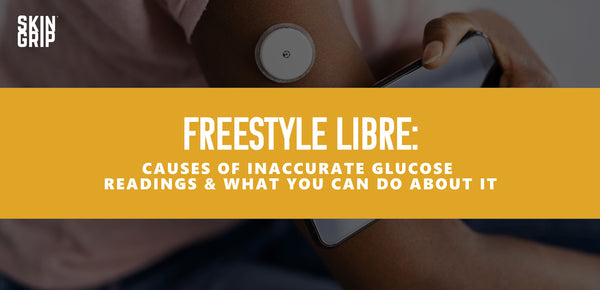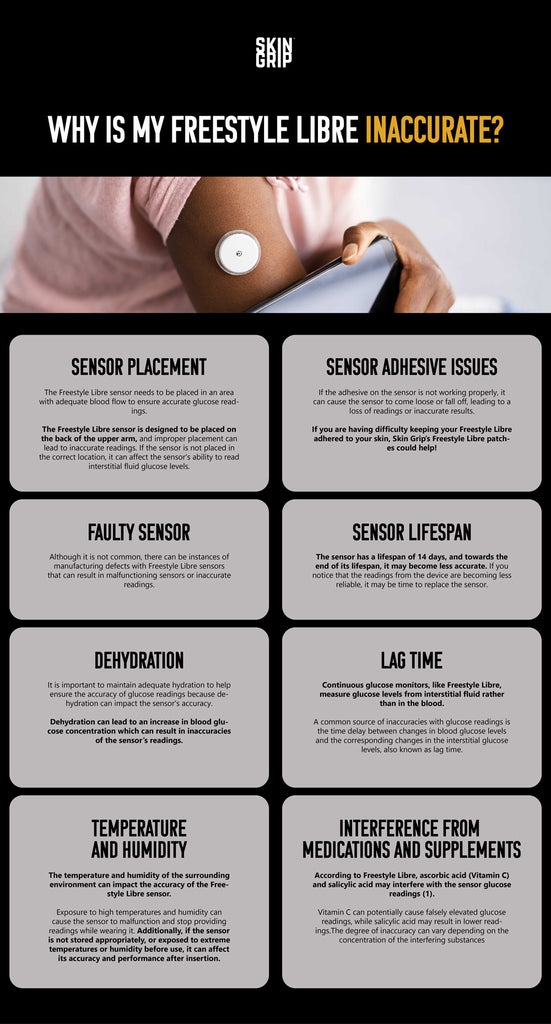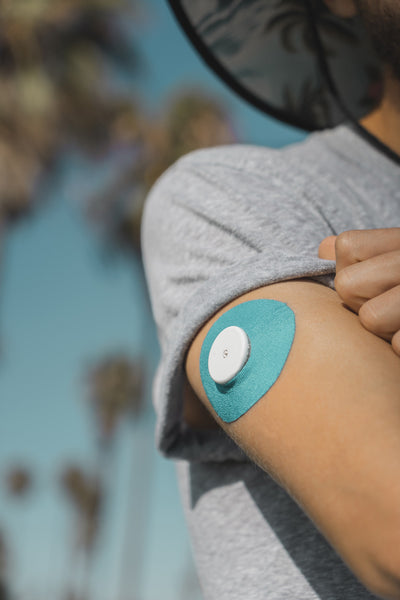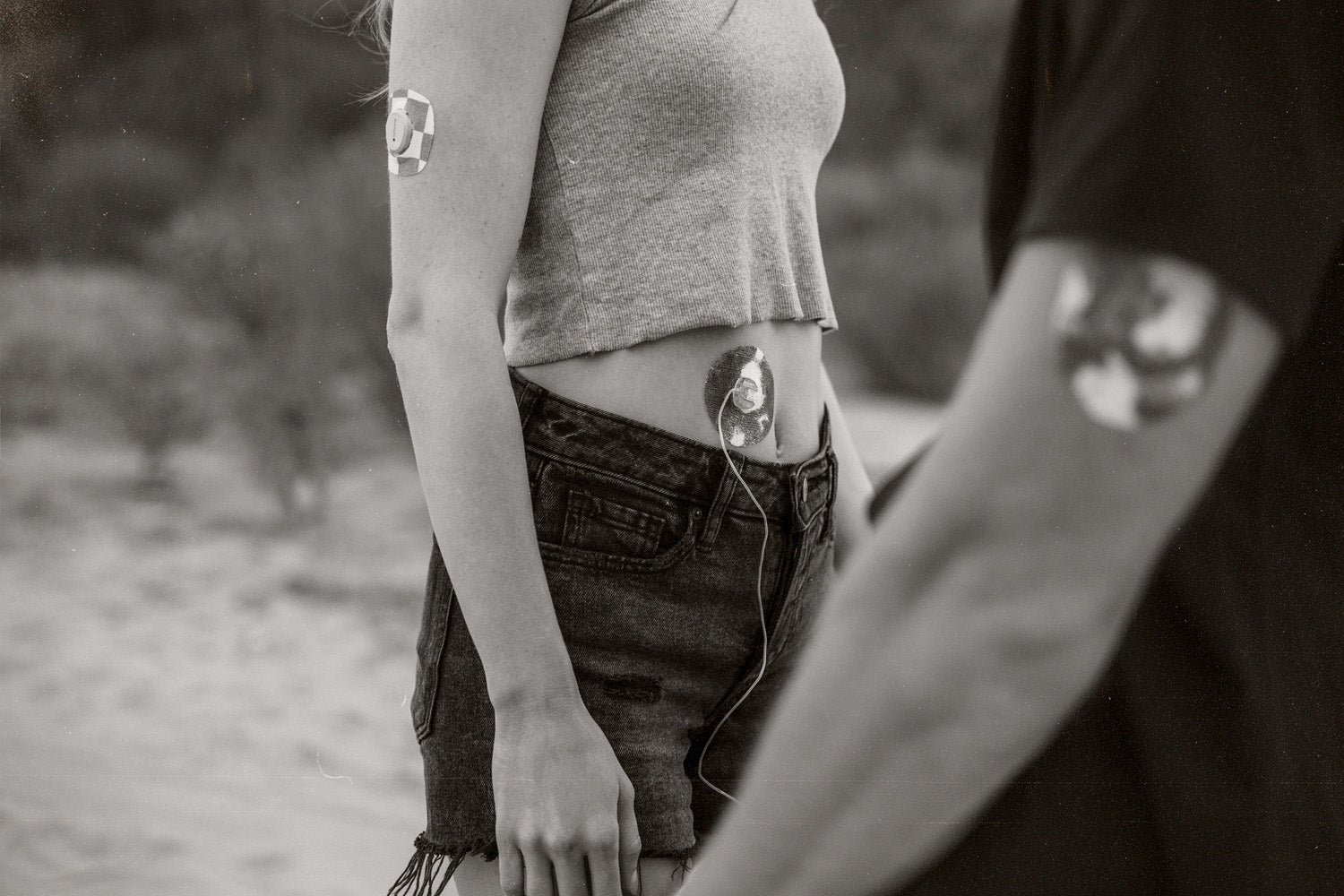
*Disclaimer: all content in this blog post is for informational and educational purposes only.
The Freestyle Libre glucose monitoring system is a popular device that allows people with diabetes to track their glucose levels easily and conveniently. However, these have been reports of inaccuracies in Freestyle Libre sensor readings. While the Freestyle Libre can help many people with diabetes manage their glucose levels, it’s important to be aware of the limitations of the technology to make informed decisions regarding your health. In this blog post, we will explore some of the inaccuracies reported with the Freestyle Libre and what you can do about it.
Why is my freestyle libre inaccurate?
There are several possible reasons why your Freestyle Libre readings may be inaccurate or inconsistent with readings from a glucose meter. Here are some of the common factors that may influence the accuracy of your Libre sensor.

Sensor Placement
The Freestyle Libre sensor needs to be placed in an area with adequate blood flow to ensure accurate glucose readings. The Freestyle Libre sensor is designed to be placed on the back of the upper arm, and improper placement can lead to inaccurate readings. If the sensor is not placed in the correct location, it can affect the sensor's ability to read interstitial fluid glucose levels.
Sensor Adhesive Issues
If the adhesive on the sensor is not working properly, it can cause the sensor to come loose or fall off, leading to a loss of readings or inaccurate results. If you are having difficulty keeping your Freestyle Libre adhered to your skin, Skin Grip’s Freestyle Libre patches could help!
Faulty Sensor
Although it is not common, there can be instances of manufacturing defects with Freestyle Libre sensors that can result in malfunctioning sensors or inaccurate readings.
Interference from medications and supplements
According to Freestyle Libre, ascorbic acid (Vitamin C) and salicylic acid may interfere with the sensor glucose readings (1). Vitamin C can potentially cause falsely elevated glucose readings, while salicylic acid may result in lower readings.The degree of inaccuracy can vary depending on the concentration of the interfering substances.
Sensor lifespan
The sensor has a lifespan of 14 days, and towards the end of its lifespan, it may become less accurate. If you notice that the readings from the device are becoming less reliable, it may be time to replace the sensor.
Dehydration
It is important to maintain adequate hydration to help ensure the accuracy of glucose readings because dehydration can impact the sensor’s accuracy. Dehydration can lead to an increase in blood glucose concentration which can result in inaccuracies of the sensor’s readings.
Lag Time
Continuous glucose monitors, like Freestyle Libre, measure glucose levels from interstitial fluid rather than in the blood. A common source of inaccuracies with glucose readings is the time delay between changes in blood glucose levels and the corresponding changes in the interstitial glucose levels, also known as lag time. When glucose levels fluctuate rapidly, the interstitial fluid glucose may take some time to catch up, which can result in falsely high or low readings.
Temperature and Humidity
The temperature and humidity of the surrounding environment can impact the accuracy of the Freestyle Libre sensor. Exposure to high temperatures and humidity can cause the sensor to malfunction and stop providing readings while wearing it. Additionally, if the sensor is not stored appropriately, or exposed to extreme temperatures or humidity before use, it can affect its accuracy and performance after insertion. Freestyle Libre recommends the sensor kits to be stored between 39-77°F and between 10-90% non-condensing humidity (2).
Why won’t finger stick readings always match sensor readings?

It's common for finger-stick blood glucose readings and sensor glucose readings to not always match. This is because sensor glucose readings are obtained from interstitial fluid, which is a fluid layer that surrounds the cells beneath the skin, rather than from blood.
Additionally, glucose needs to enter the bloodstream before it can reach the interstitial fluid, resulting in a delay between blood glucose and interstitial fluid glucose readings. As a result, variations between the two types of readings are more noticeable during periods of rapid glucose change, such as after meals, insulin dosing, and physical activity (3).
What to do if your Freestyle Libre sensor is inaccurate
It is normal to see your Freestyle Libre sensor readings be lower or higher than your blood glucose readings particularly after meals, insulin or exercise. Freestyle Libre recommends making treatment decisions off of glucose meters if the sensor readings do not match how you feel (4).
Can you calibrate Freestyle Libre sensors?
Freestyle Libre systems are factory calibrated and do not require manual calibration by the user. However, if you are experiencing inconsistent or inaccurate readings, there are a few steps you can take to troubleshoot the issue:
1. Make sure that the sensor is placed on the back of your upper arm in the correct location, as instructed in the user manual.
2. Wait until the sensor fully activates before taking any readings.
3. Do not expose the sensor and reader to extreme temperatures or direct sunlight for extended periods of time. Store unused/unopened sensors in a cool, dry place.
4. Ensure that the area where the sensor is applied is clean and dry, avoiding applying any creams or lotions to the skin.
5. Make sure the adhesive is secured in place. If the sensor is not secure, it may not be able to obtain an accurate reading.
When to Remove a Freestyle Libre Sensor
Freestyle Libre advises users to replace their sensor if they experience any irritation or discomfort at the insertion site or if your phone or reader reports a problem with the sensor in use (5). In case the sensor is loose or if the sensor tip is dislodged from the skin, you may get no readings or unreliable readings. To ensure accuracy, it is recommended to perform a finger-stick blood glucose test if readings appear incorrect or inconsistent with how you feel. If the problem persists, Freestyle Libre suggests removing the faulty sensor, applying a new one, and contacting their customer service team for further assistance.
References:
- https://prescriptionhope.com/
- https://skingrip.com/products/skin-grip-freestyle-libre-3-adhesive-patches
- https://www.freestyle.abbott/us-en/safety-information.html
- https://www.freestyle.abbott/us-en/safety-information.html
- https://www.freestylelibre.com.au/difference-between-glucose-interstitial-glucose#:~:text=Finger%20prick%20blood%20glucose%20readings%20and%20sensor%20glucose%20readings%20won,skin%2C%20not%20from%20your%20blood.
- https://www.freestyleprovider.abbott/us-en/safety-information.html#:~:text=using%20the%20System.-,Contact%20your%20healthcare%20professional%20before%20continuing%20to%20use%20the%20System,readings%20or%20unreliable%20low%20readings.
- https://freestyleserver.com/Payloads/IFU/2020/q2/DOC40613_rev-F/English/Assets/sensor_removing_your_sensor.html






























